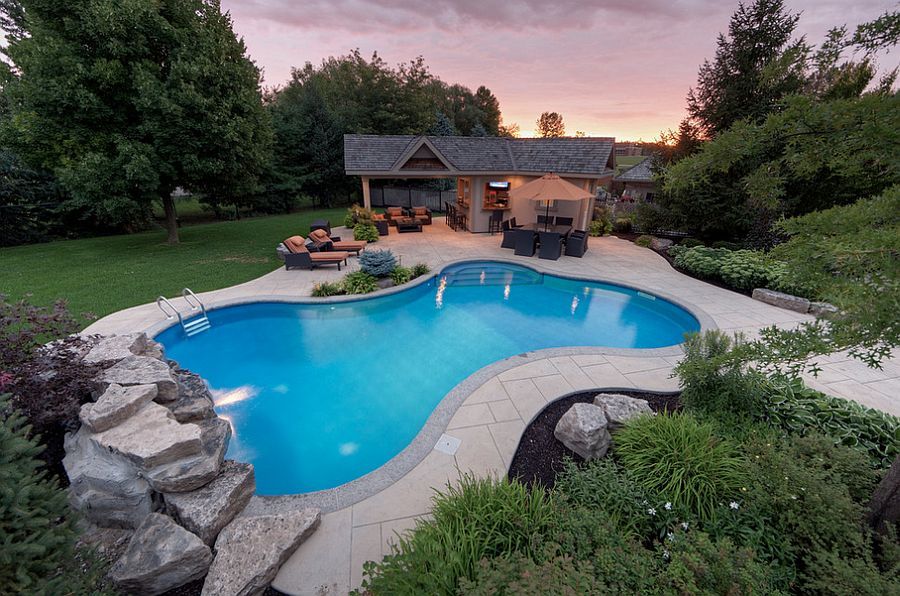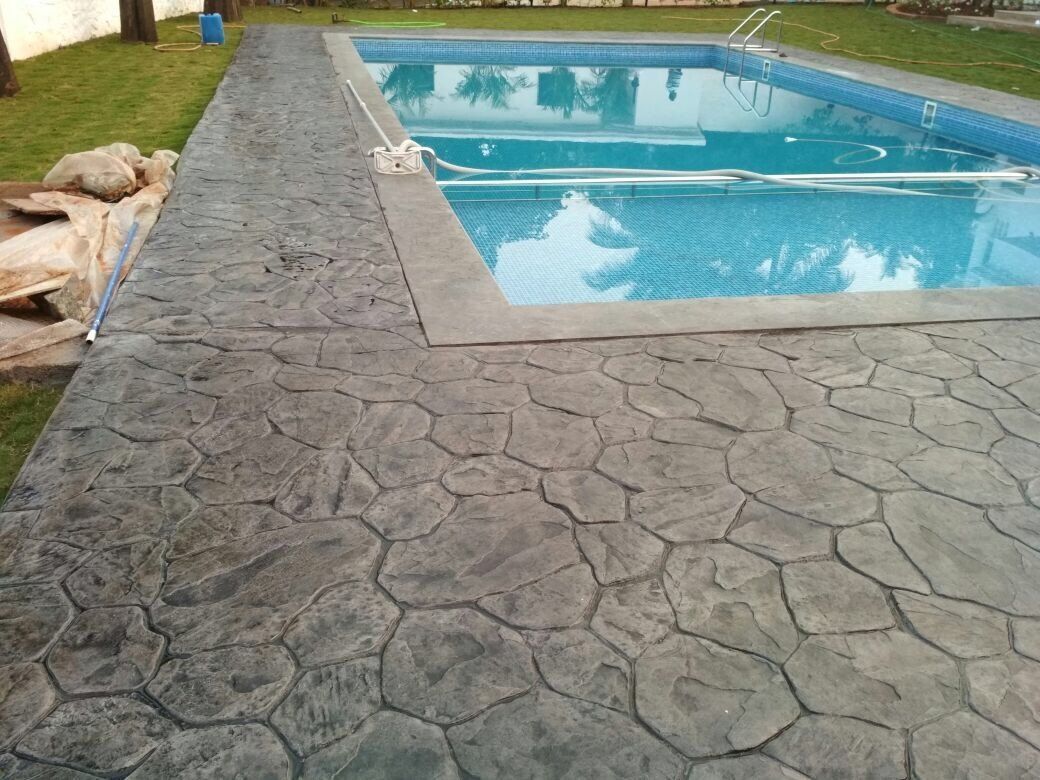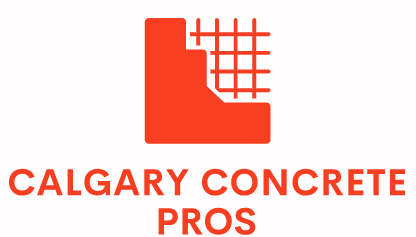Calgary Concrete Pros
Concrete Pool Decks Calgary
At Calgary Concrete Pros we believe a very important piece of an inground pool installation is creating the pool decking, which is an integral part of the entire focal point that is the pool. Pool decking is the surface installed around the perimeter of your pool that creates a space for poolside furniture or areas to relax out of the water. A beautifully constructed pool deck enhances the visual aspect of your backyard. Pool decks can be made from many different materials, but concrete has benefits that others don’t.
Whether you’re putting in a brand-new pool or you’re replacing or resurfacing your existing concrete, it’s important to consider all the pool decking options when deciding which material to use.
Concrete is a popular choice for pool decks because it's durable, low maintenance, and can be customized to match any style:
Durability: Extreme durability is just one of the many qualities that makes concrete such a great option for pool decks. It can also be textured to stay cool and prevent slipping.
Low maintenance: Concrete is easy to maintain when sealed properly.
Customization: Concrete can be textured to prevent slipping and stay cool, and it can be stamped or applied to create a variety of looks. Concrete can also be used to replicate more expensive materials like stone, slate, or wood.

Get Instant Quote
We will get back to you as soon as possible.
Please try again later.

What Decking Is Best Around a Pool?
When considering a variety of factors such as safety, maintenance, temperature of surface, versatility of appearance, and cost, concrete is often considered the best pool deck material, offering clear benefits over other options. Safety. Slip-resistance should be of high importance to anyone putting in a pool deck. Although there’s no such thing as non-slip pool deck surfaces, you can take steps to reduce slipperiness. With concrete, you can have your surface textured to prevent slip-and-fall accidents. Another option is to include slip-resistant additives in your sealer. If you do that, it’s critical to reapply sealer so the slip-resistance does not wear out. Maintenance. Properly caring for a concrete pool deck requires brushing and spraying off the surface every so often to prevent staining. It’s also important to have the surface sealed every few years to protect it from chlorine, sunscreen, and other contaminants. Temperature of surface. When textured and colored properly, concrete is comfortable for bare feet on hot days, especially when compared to pavers which can get extremely hot to the touch.
Versatility of appearance. With concrete, you can customize the appearance of your pool deck to fit your style. A variety of looks can be achieved using stamped concrete, exposed aggregate, and stained concrete cost. When compared to other pool decking material options, the long-term cost of a concrete pool deck is one of the least expensive options. Natural stone, for example, is costly on its own, and there is an additional cost for labor if you are having someone lay the stones. Plus, if you cut corners and opt for cheaper materials, you’ll end up having to replace them after a few years. A concrete pool deck that’s installed and cared for properly will last for decades.
Why Concrete For a Pool Deck
Concrete is a good choice for many reasons, if you’re looking for something simple, classic, and affordable, concrete may be your number one pick. Even if you have your heart set on a different material, like stone or wood, you might still want to consider concrete for around your pool.
You might be thinking that concrete is boring, but you are not bound to the plain concrete that you see on old sidewalks and driveways. To start, you’ll have a choice between broomed concrete, stamped concrete, and textured concrete.
Broom Finished Concrete
Broomed or brushed concrete is a textured concrete that creates a slip-resistant surface with a little bit more character than plain concrete. This is achieved by dragging a broom across the top of the concrete before it sets to give it the “broomed” texture.
Stamped Concrete
If you ever wanted all wood or premium stone decking around your swimming pool but couldn’t afford it, then stamped concrete might be exactly what you need. Stamped concrete can not only imitate other deck and patio materials, but it’s also a durable and cost-effective alternative compared to the real counterparts. Just to name a few of the options that you have when it comes to stamped concrete patterns, you can pick from…
- Brick
- Wood
- Travertine
- Flagstone
- Slate
- Cobblestone
- Natural stone
Textured Concrete
You can think of textured concrete as a happy middle ground between broomed and stamped concrete. Textured concrete is stamped to give it a texture that adds both grip and character, but it doesn’t require color or sealant, making it both cheaper and less slippery than stamped concrete.
Concrete Pool Deck Cons
Concrete decks aren’t all play and no work. There are a few disadvantages that you need to consider as well if you’re thinking about putting in a concrete pool deck, including:
Colors can be difficult to match
If you want colored concrete, or if you’re choosing a stamped concrete design, it’s important to know that concrete is not always easy to match. If you’re doing part of your pool deck or patio now and plan to expand it later, you will need to consider how you want to hide the subtle change in color. To deal with this, consider doing a different stamped concrete pattern, color, or even a different patio material altogether in the expanded section.
Pool concrete decking can be slippery
This is not really something that you have to worry about with plain, broomed, or textured concrete, but if you want stamped concrete, you have to consider the fact that it can be slippery. Stamped concrete uses a couple of colors to achieve the look of other decking materials, and to preserve this look, it’s typically sealed with a silicone or acrylic sealant.
This seal can make the deck or patio a bit slippery, which is obviously not always ideal near the pool. Textured concrete, which is not sealed, is an excellent alternative if you like the style of stamped concrete but are worried about your children or guests slipping on the patio.
Concrete cracks...it’s inevitable
Unfortunately, there’s really nothing that you can do to prevent your concrete deck from cracking, but you can try to control where the cracks occur. This is why we create control joints, which are intentional breaks in the concrete where the cracks can form without disturbing the design.
How much does a concrete pool deck cost
The cost of a concrete pool deck will vary depending on the demands of your project, such as the size, style, and type of concrete you want to use.
How long does a concrete pool deck last?
Concrete pool decks typically last 20–25 years
How do I maintain a concrete pool deck?
To maintain a concrete pool deck, you should:
Brush and spray: Regularly brush and spray the surface to prevent staining.
Reseal: Every few years, reseal the surface to protect it from chlorine, sunscreen, and other pollutants.
How can I prevent tripping hazards?
Concrete can shift over time, which can create a tripping hazard. We can repair tripping hazards with mudjacking, sand-jacking, poly-jacking, demolition and replacement, or grout filling
What Are the Signs That a Concrete Pool Deck Needs to Be Replaced?
Here are some signs that your pool deck needs to be replaced
The pool deck is no longer level
There are cracks in the concrete
The surface of the concrete is crumbling or flaking off
The concrete is discolored
Quick & Reliable
Site Map
Privicy Policy/Terms of Service
All Rights Reserved | Calgary Concrete
